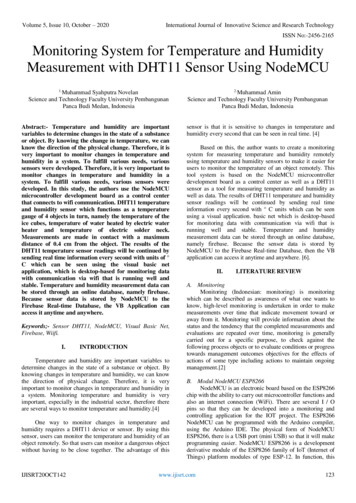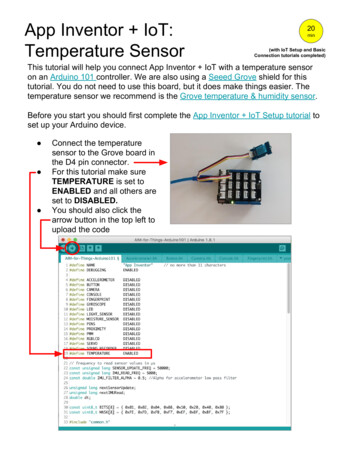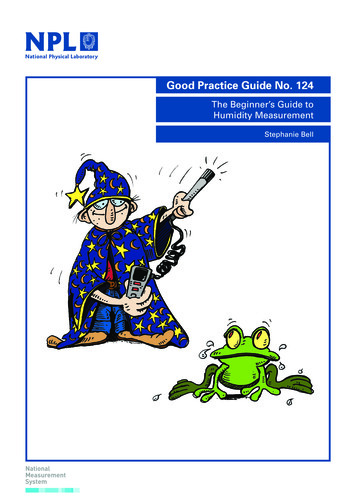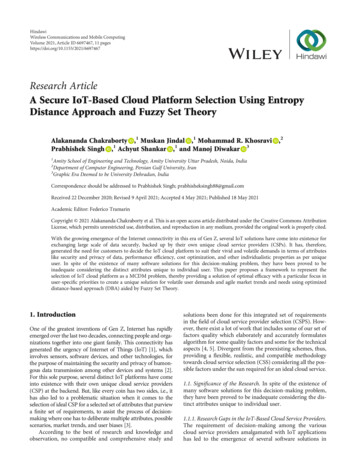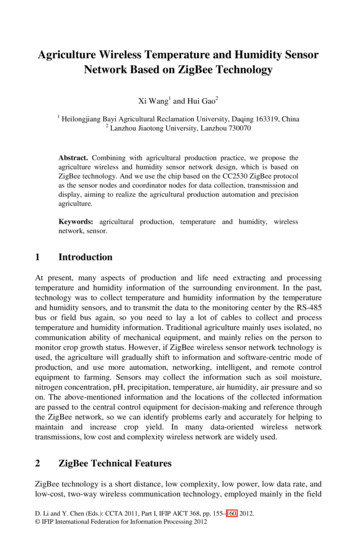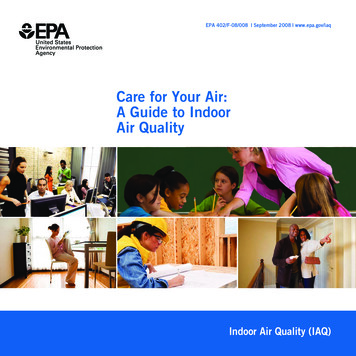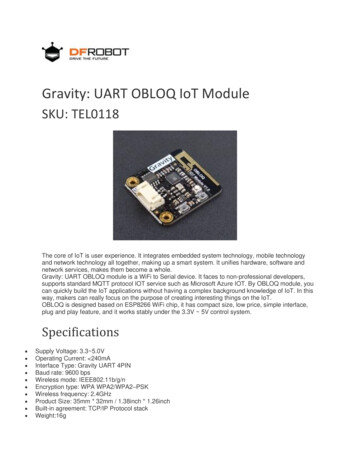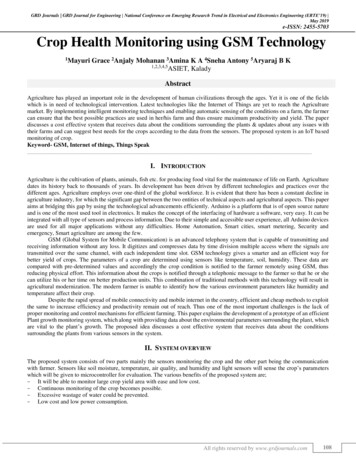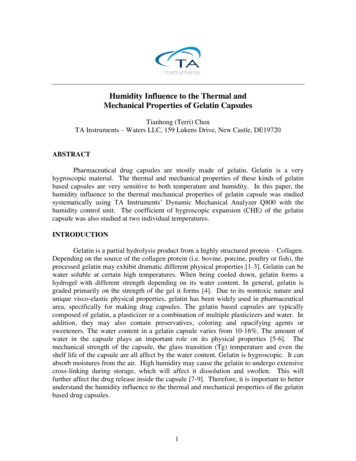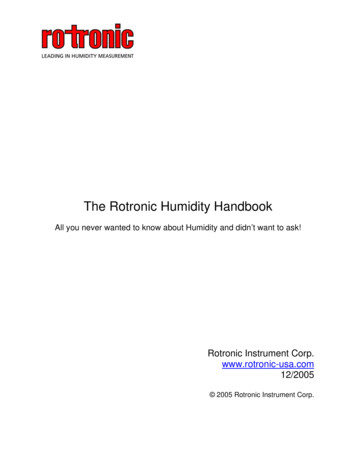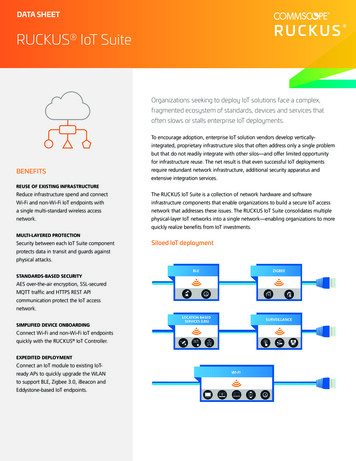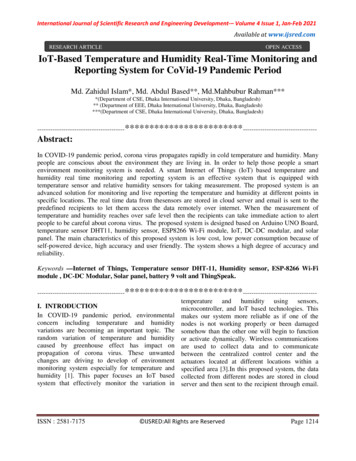
Transcription
International Journal of Scientific Research and Engineering Development-– Volume 4 Issue 1, Jan-Feb 2021Available at www.ijsred.comRESEARCH ARTICLEOPEN ACCESSIoT-Based Temperature and Humidity Real-Time Monitoring andReporting System for CoVid-19 Pandemic PeriodMd. Zahidul Islam*, Md. Abdul Based**, Md.Mahbubur Rahman****(Department of CSE, Dhaka International University, Dhaka, Bangladesh)** (Department of EEE, Dhaka International University, Dhaka, Bangladesh)***(Department of CSE, Dhaka International University, Dhaka, ---------Abstract:In COVID-19 pandemic period, corona virus propagates rapidly in cold temperature and humidity. Manypeople are conscious about the environment they are living in. In order to help those people a smartenvironment monitoring system is needed. A smart Internet of Things (IoT) based temperature andhumidity real time monitoring and reporting system is an effective system that is equipped withtemperature sensor and relative humidity sensors for taking measurement. The proposed system is anadvanced solution for monitoring and live reporting the temperature and humidity at different points inspecific locations. The real time data from thesensors are stored in cloud server and email is sent to thepredefined recipients to let them access the data remotely over internet. When the measurement oftemperature and humidity reaches over safe level then the recipients can take immediate action to alertpeople to be careful about corona virus. The proposed system is designed based on Arduino UNO Board,temperature sensor DHT11, humidity sensor, ESP8266 Wi-Fi module, IoT, DC-DC modular, and solarpanel. The main characteristics of this proposed system is low cost, low power consumption because ofself-powered device, high accuracy and user friendly. The system shows a high degree of accuracy andreliability.Keywords —Internet of Things, Temperature sensor DHT-11, Humidity sensor, ESP-8266 Wi-Fimodule , DC-DC Modular, Solar panel, battery 9 volt and --------temperature and humidity using sensors,I. INTRODUCTIONmicrocontroller, and IoT based technologies. ThisIn COVID-19 pandemic period, environmental makes our system more reliable as if one of theconcern including temperature and humidity nodes is not working properly or been damagedvariations are becoming an important topic. The somehow than the other one will begin to functionrandom variation of temperature and humidity or activate dynamically. Wireless communicationscaused by greenhouse effect has impact on are used to collect data and to communicatepropagation of corona virus. These unwanted between the centralized control center and thechanges are driving to develop of environment actuators located at different locations within amonitoring system especially for temperature and specified area [3].In this proposed system, the datahumidity [1]. This paper focuses an IoT based collected from different nodes are stored in cloudsystem that effectively monitor the variation in server and then sent to the recipient through email.ISSN : 2581-7175 IJSRED:All Rights are ReservedPage 1214
International Journal of Scientific Research and Engineering Development-– Volume X Issue X, YearAvailable at www.ijsred.comThe recipient can monitor the variation intemperature and humidity both in the indoor and Arduino UNO is a microcontroller board based onthe ATmega328P (datasheet). It has 14 digital I/Ooutdoor environment using this proposed system.pins, 6 analog inputs, a 16 MHz ceramic resonator(CSTCE16M0V53-R0), a USB connection, a powerII. RELATED WORKjack, an ICSP header and a reset button. Six digitalA system is developed in [1] to sends measurement pins can be used as PWM outputs It containsdata of temperature and humidity to a cloud everything needed to support the microcontroller;platform using HTTP (Hypertext Transfer simply connect it to a computer with a USB cableProtocol)based servicesusing energy autonomous or power it with an AC-to-DC adapter or battery towireless sensors. Air quality monitoring device [2] get started. Fig. 1 shows the Arduino UNO Board.monitors overall toxic gases like NOx, CO2,benzene and smoke by comprising of a NodeMCUESP32, a MQ-135 gas sensor and a DHT-11temperature and humidity sensor module. Alsodisplays an alert message on server if the air Monitoringandautomaticcorrection system set-up in a temperature controlledgreenhouse including pH level and temperature ofFig. 1: Arduino UNO Boardthe recirculating water [4]. A remote monitoring The ESP8266 is a Wi-Fi module that allowssystem of temperature and humidity based onmicrocontrollers access to a Wi-Fi network. ThisOneNetcloudserviceequippedwithSTM32F103RCT6 of ARM CortexM3 kernel, module is a self-contained SOC (System on a Chip)SIM800C communication module and GSM/GPRS that does not necessarily need a microcontroller tocellular communication technology having data manipulate inputs and outputs. Fig. 2 shows thedetection and alarming function [5]. Anotherproposed system is developed to observe airpollution information at public facilities or homeswhich is capable to collect and analyze atmosphericenvironment measurement results in a serverthrough an LTE communication network [6, 8].AnIoT-based environmental monitoring system isdeveloped for indoor workplaces to compare theenergy consumptions for environmental controlESP8266 Wi-Fi Module.with the real environmental wellness [7]. SmartFig. 2: ESP8266 Wi-Fi Moduleenvironmental monitoring isto help in the The DHT-11 sensor is made of two parts, aprotection of environment via parameters for capacitive humidity sensor and a thermistor. It is amonitoring such as quality of air and quality ofdevice of ultra-low cost with 1 Hz sampling ratewater [9].(once every second). It provides 20-80% humidityIII.DESIGN METHODOLOGYreadings with 5% accuracy and 0-50 C temperatureThe system consists of a temperature and humidity readings with 2 C accuracy.sensor DHT11, ESP8266 WiFi module, DC-DC Fig. 3 shows the DHT-11 sensor.Motor, Solar panel and Arduino UNO Board.ISSN : 2581-7175 IJSRED: All Rights are ReservedPage 1215
International Journal of Scientific Research and Engineering DevelopmentDevelopment-– Volume X Issue XX, YearAvailable at www.ijsred.comFig. 3: DHT-11The DC-DC module is an efficient MOSFETOSFET switchtube thatmakes efficiency up to 94 percent(LM2577 current only 3 amp).). It is highhi switchingfrequency (400 KHZ) that can use the smallcapacity of the filter capacitor can achieve verygood effect, ripple smaller and smaller. Fig. 4shows the DC-DC module.Fig. 6: Architectural Design of Temperature and Humidity MonitoringSystemThe circuit diagram and connection status ofo thissystem is shown in Fig. 7.Fig. 4: DC-DC ModuleThis system uses Mini polycrystalline solarsol Panelthat is shown in Fig. 5.(a)(b)Fig. 5: Solar PanelFig. 7: (a) Circuit diagram (b) Connection devicesIV.SYSTEM SIMULATION11 circuit diagram with testingThe system architecture is done in 4 stages of IoT Arduino and DHT-11resultisshowninFigure8(a)(a) and 8(b).architecture that is a collection of numerouselements: sensors, protocols, actuators, cloudservices, and layers.The architectural design of temperature andhumidity monitoring system is shown in Fig. 6. IJSRED: All Rights are ReservedPage 1216
International Journal of Scientific Research and Engineering DevelopmentDevelopment-– Volume X Issue XX, YearAvailable at www.ijsred.comFig. 8 (a): Circuit Diagram of Arduino and DHT-11DHTFig. 10 (a): Circuit Diagram of Arduino Uno, DHT11 and ESP8266Fig. 8 (b): Testing Result of Arduino and DHT-11DHTArduino and ESP8266 circuit diagram with testingresult is shown in Figure 9(a) and 9(b).Fig. 10 (b): Testing Result of ArduinoUno , DHT11 and ESP8266V. CIRCUIT DESIGN AND DEVICE MODELFig. 9 (a): Circuit Diagram of Arduino Uno and ESP8266This section shows pictorial representation of thecircuit design and device model that are used in oursystem.The design of circuitircuit is shown in Fig. 11(a), 11(b),and 11(c).Fig. 9 (b): Testing Result of Arduino UNO and ESP8266Arduino, DHT11 and ESP8266 circuit diagram withtesting result is shown in Figure 10(a)(a) and 10(b). IJSRED: All Rights are ReservedFig. 11(a):: Circuit DesignPage 1217
International Journal of Scientific Research and Engineering Development-– Volume X Issue X, YearAvailable at www.ijsred.comis 18 C and a maximum temperature is 30 C orexceed the humidity limit, that is, air humidity of atleast 65% and maximum humidity of 80%, if thelimit exceeds an email will be sent to the recipients.The system flowchart for monitoring temperatureand humidity is illustrated in Fig. 13.Fig. 11(b): Circuit DesignFig. 11(c): Circuit DesignThe Device Model in various positions is shown inFig. 12.Fig. 13: System Flowchart for Temperature and Humidity MonitoringSystemVII. EXPERIMENTAL RESULTSIn this system, we use android apps named“Thingview” which is android based wirelesscommunication system. The user interface of ourapps is shown in Fig. 14.Fig. 12: Device ModelVI.SYSTEM FLOWCHARTThe proposed system uses the first sensor onArduino UNO to read temperature and humiditydata for every minute and these data are stored inthe cloud server database. Air temperature andhumidity data are checked whether they exceed thetemperature limit in which a minimum temperatureISSN : 2581-7175Fig. 14: The user interface of apps IJSRED: All Rights are ReservedPage 1218
International Journal of Scientific Research and Engineering DevelopmentDevelopment-– Volume X Issue XX, YearAvailable at www.ijsred.comThe reading status of temperature and humidity ofboth channels of our apps is shown in Fig.F 15(a)and 15(b).Fig. 16 (b): Channel Status of Channel IDID-998897Fig. 15 (a): Reading status of temperature and humidity of Channel 998897(DIU)Fig. 16 (c): Channel Status of Channel IDID-1006505Fig. 15 (b): Reading status of temperature and humidity of Channel 1006505(Motijil)The interface of creating channels with status isshown in Fig. 16(a), 16(b), and 16(c).Sensor value with the variation of histogram oftemperature is shown in Fig. 17(a) and 17(b).Fig. 16 (a): Interface of creating channels IJSRED: All Rights are ReservedFig. 17 (a): Sensor ValuValuePage 1219
International Journal of Scientific Research and Engineering DevelopmentDevelopment-– Volume X Issue XX, YearAvailable at www.ijsred.comData analysis of temperature and humidity forcertain amount of time is shown in Fig. 19(a) and19(b).30 Entry AVG Value14016014012012010010080806060Fig. 17 (b): Histogram of variation of 01-21302311-23402521-2550IFTTT Mail Configuration with acceptance isshown in Fig. 18(a) and 18(b).AVG TempAVG HumidityFig. 19 (a): Temperature and humidity AVG ValueGrand AVGFig. 18(a): IFTTT Mail Configuration806068.890689664030.78666667200AVG TempAVG HumidityFig. 19 (b): Total temperature-humidityhumidity Data AvgFig. 18(b): Acceptance of MailCloud platform data curve and data sheet is shownin Fig. 20(a) and 20(b). IJSRED: All Rights are ReservedPage 1220
International Journal of Scientific Research and Engineering DevelopmentDevelopment-– Volume X Issue XX, YearAvailable at www.ijsred.comREFERENCES[1][2][3][4]Fig. 20 (a): Cloud platform data curve[5][6][7][8][9]Fig. 20 (b): Cloud platform data sheetG. Mois, Z. Szilagyi, T. Sanislav and S. Folea, "An HTTPHTTP-basedenvironmental monitoring system using power harvesting," 2017 21stInternational Conference on System Theory, Control and .1109/ICSTCC.2017.8107142.B. K. Moharana, P. Anand, S. Kumar and P. Kodali, "De"Development ofan IoT-based Real-TimeTime Air Quality Monitoring Device," 2020International Conference on Communication and Signal ,doi:10.1109/ICCSP48568.2020.9182330.S. Saha and A. Majumdar, "Data centre temperature monitoring withESP8266 based Wireless Sensor Network and cloud based dashboardwith real time alert system," 2017 Devices for Integrated 109/DEVIC.2017.8073958.L. K. S. Tolentino et al., "Development of an IoTIoT-based AquaponicsMonitoring and Correction System with TemperatureTemperature-ControlledGreenhouse," 2019 International SoC Design Conference 0.1109/ISOCC47750.2019.9027722.J. Du, J. Guo, D. Xu and Q. Huang, "A remote monitoring system oftemperature and humidity based on OneNet cloud service platform,"2017 IEEE Electrical Design of Advanced Packaging and 0.1109/EDAPS.2017.8277059.S. H. Kim, J. M. Jeong, M. T. Hwang and C. S. Kang, "Developmentof an IoT-basedbased atmospheric environment monitoring system," 2017International Conference on Information and CommunicationTechnology Convergence (ICTC), Jeju, 2017, pp. 861861-863, doi:10.1109/ICTC.2017.8190799.D. Assante and C. Fornaro, "An Educational IoTIoT-based IndoorEnvironment Monitoring System," 2019 IEEE Global EngineeringEducation Conference (EDUCON), Dubai, United Arab Emirates,2019, pp. 1475-1479,1479, doi: 10.1109/EDUCON.2019.8725262.D. Pujara, P. Kukreja and S. Gajjar, "Design and Development of EESense: IoT based Environment Monitoring System," 2020 IEEEStudents Conference on Engineering & Systems (SCES), Prayagraj,India, 2020, pp. 1-5,5, doi: 10.1109/SCES50439.2020.9236768.A. K. Singh,ngh, M. Raj and V. Sharma, "Architecture, Issues andChallenges in Monitoring based on IoT for Smarter Environment,"2020 Fourth International Conference on Computing Methodologiesand Communication (ICCMC), Erode, India, 2020, pp. 142142-146, . CONCLUSIONSThe proposed system in this paper has been carriedout to monitor real-timetime condition (Humidity andanTemperature) through internet. This does notrequire physical presence andnd can save human workand will be a very effective way of monitoringenvironment during the COVID-1919 pandemicsituation. The system can retrieve temperature andhumidity data on the server room and thetemperature and humidity data that has been takencan be displayed on the website in graphical form.The advantages of this research work are that thissystem can also regulate the humidity in the serverroom and use one of the tools as sensors andactuators. The system also can send notifications tothe respective stakeholders. IJSRED: All Rights are ReservedPage 1221
The proposed system is designed based on Arduino UNO Board, temperature sensor DHT11, humidity sensor, ESP8266 Wi-Fi module, IoT, DC-DC modular, and solar panel. The main characteristics of this proposed system is low cost, low power consumption because of self-powered device, high accuracy and user friendly. The system shows a high degree of accuracy and reliability. Keywords —Internet of .
